A Bibliometric Analysis of Service Climate as a Sustainable Competitive Advantage in Hospitality
Abstract
:1. Introduction
2. Service Climate in Hospitality
3. Methodology
3.1. Collection and Strategy
3.2. Analysis and Visualization
4. Results and Discussion
4.1. Retrieved Literature
4.2. Sources
4.3. Authors
4.4. Countries
4.5. Quotations
4.6. Keywords
4.7. Structures
4.7.1. Conceptual
4.7.2. Intellectual
4.7.3. Social
4.8. Content Analysis
5. Conclusions and Implications
6. Limitations
7. Future Research
Author Contributions
Funding
Institutional Review Board Statement
Informed Consent Statement
Acknowledgments
Conflicts of Interest
References
- Mittal, V.; Han, K.; Westbrook, R.A. Customer engagement and employee engagement: A research review and agenda. Cust. Engagem. Mark. 2018, 173–201. [Google Scholar] [CrossRef]
- Voola, R.; Carlson, J.; West, A. Emotional intelligence and competitive advantage: Examining the relationship from a resource-based view. Strat. Chang. 2004, 13, 83–93. [Google Scholar] [CrossRef]
- Barney, J.B. Is the Resource-Based “View” a useful perspective for strategic management research? Yes. Acad. Manag. Rev. 2001, 26, 41. [Google Scholar]
- Lippman, S.A.; Rumelt, R.P. Uncertain imitability: An analysis of interfirm differences in efficiency under competition. Bell J. Econ. 1982, 13, 418–438. [Google Scholar] [CrossRef]
- Dierickx, I.; Cool, K. Asset stock accumulation and sustainability of competitive advantage. Manag. Sci. 1989, 35, 1504–1511. [Google Scholar] [CrossRef] [Green Version]
- Reed, R.; DeFillippi, R.J. Causal ambiguity, barriers to imitation, and sustainable competitive advantage. Acad. Manag. Rev. 1990, 15, 88–102. [Google Scholar] [CrossRef]
- Barney, J.B.; Wright, P.M. On becoming a strategic partner: The role of human resources in gaining competitive advantage. Hum. Resour. Manag. 1998, 37, 31–46. [Google Scholar] [CrossRef]
- Hitt, M.A.; Bierman, L.; Shimizu, K.; Kochhar, R. Direct and moderating effects of human capital on strategy and performance in professional service firms: A resource-based perspective. Acad. Manag. J. 2001, 44, 13–28. [Google Scholar]
- Schneider, B. The perception of organizational climate: The customer’s view. J. Appl. Psychol. 1973, 57, 248. [Google Scholar] [CrossRef]
- Price, D.O.; Lewin, K.; Cartwright, D. Field theory in social science: Selected theoretical papers. Am. Sociol. Rev. 1951, 16, 404. [Google Scholar] [CrossRef]
- Smith, O.W.; Smith, P.C.; Litwin, G.H.; Stringer, R.A. Motivation and organizational climate. Am. J. Psychol. 1969, 82, 554. [Google Scholar] [CrossRef]
- Tagiuri, R.; Litwin, G.H.; Barnes, L.B. Organizational Climate: Explorations of a Concept; Harvard University: Cambridge, MA, USA, 1968. [Google Scholar]
- Schneider, B.; White, S.S.; Paul, M.C. Linking service climate and customer perceptions of service quality: Tests of a causal model. J. Appl. Psychol. 1998, 83, 150. [Google Scholar] [CrossRef] [PubMed]
- Schneider, B.; Parkington, J.J.; Buxton, V.M. Employee and customer perceptions of service in banks. Adm. Sci. Q. 1980, 25, 252. [Google Scholar] [CrossRef]
- Hofmann, D.A.; Stetzer, A. A cross-level investigation of factors influencing unsafe behaviors and accidents. Pers. Psychol. 1996, 49, 307–339. [Google Scholar] [CrossRef]
- Anderson, N.R.; West, M.A. Measuring climate for work group innovation: Development and validation of the team climate inventory. J. Organ. Behav. Int. J. Ind. Occup. Organ. Psychol. Behav. 1998, 19, 235–258. [Google Scholar] [CrossRef]
- Raub, S.; Liao, H. Doing the right thing without being told: Joint effects of initiative climate and general self-efficacy on employee proactive customer service performance. J. Appl. Psychol. 2012, 97, 651–667. [Google Scholar] [CrossRef] [Green Version]
- Bowen, D.E.; Schneider, B. A service climate synthesis and future research agenda. J. Serv. Res. 2014, 17, 5–22. [Google Scholar] [CrossRef]
- Ployhart, R.E.; Van Iddekinge, C.H.; MacKenzie, W.I., Jr. Acquiring and developing human capital in service contexts: The interconnectedness of human capital resources. Acad. Manag. J. 2011, 54, 353–368. [Google Scholar] [CrossRef]
- Barney, J. Firm resources and sustained competitive advantage. J. Manag. 1991, 17, 99–120. [Google Scholar] [CrossRef]
- Aria, M.; Cuccurullo, C. bibliometrix: An R-tool for comprehensive science mapping analysis. J. Informetr. 2017, 11, 959–975. [Google Scholar] [CrossRef]
- Diodato, V.P.; Gellatly, P. Dictionary of Bibliometrics; Routledge: Oxfordshire, UK, 2013. [Google Scholar]
- Aria, M.; Misuraca, M.; Spano, M. Mapping the evolution of social research and data science on 30 years of social indicators research. Soc. Indic. Res. 2020, 149, 803–831. [Google Scholar] [CrossRef]
- Cuccurullo, C.; Aria, M.; Sarto, F. Foundations and trends in performance management. A twenty-five years bibliometric analysis in business and public administration domains. Scientometrics 2016, 108, 595–611. [Google Scholar] [CrossRef]
- Rebelo, T.; Gomes, D. Organizational Learning and Learning Organizations. Available online: ttp://hdl.handle.net/10316.2/2953 (accessed on 28 March 2021).
- Krasulja, N.; Radojević, I.; Janjušić, D. Holacracy-the new management system. In Proceedings of the International Scientific Conference, Njs, Serbia, 13 October 2016. [Google Scholar]
- Eckstein, J. Sociocracy: An organization model for large-scale agile development. In Proceedings of the Scientific Workshop Proceedings of XP2016, Edinburgh, Scotland, 24 May 2016; pp. 1–5. [Google Scholar]
- Solnet, D.; Kandampully, J. How some service firms have become part of “service excellence” folklore. Manag. Serv. Qual. Int. J. 2008, 18, 179–193. [Google Scholar] [CrossRef]
- Johanson, M.M.; Woods, R.H. Recognizing the emotional element in service excellence. Cornell Hosp. Q. 2008, 49, 310–316. [Google Scholar] [CrossRef]
- Schneider, B.; Bowen, D.E. Winning the service game. In Handbook of Service Science, Volume II; Springer: Berlin/Heidelberg, Germany, 2010; pp. 31–59. [Google Scholar]
- Michel, J.W.; Kavanagh, M.J.; Tracey, J.B. Got support? The impact of supportive work practices on the perceptions, motivation, and behavior of customer-contact employees. Cornell Hosp. Q. 2013, 54, 161–173. [Google Scholar] [CrossRef] [Green Version]
- He, Y.; Li, W.; Lai, K.K. Service climate, employee commitment and customer satisfaction. Int. J. Contemp. Hosp. Manag. 2011, 23, 592–607. [Google Scholar] [CrossRef] [Green Version]
- Sadeghi, M.; Zandieh, D.; Mohammadi, M.; Yaghoubibijarboneh, B.; Vosta, S.N. Investigating the impact of service climate on intention to revisit a hotel: The mediating role of perceived service quality and relationship quality. Int. J. Manag. Sci. Eng. Manag. 2016, 12, 12–20. [Google Scholar] [CrossRef]
- Salanova, M.; Agut, S.; Peiró, J.M. Linking organizational resources and work engagement to employee performance and customer loyalty: The mediation of service climate. J. Appl. Psychol. 2005, 90, 1217–1227. [Google Scholar] [CrossRef] [PubMed]
- Susskind, A.M.; Kacmar, K.M.; Borchgrevink, C.P. The Relationship of service providers’ perceptions of service climate to guest satisfaction, return intentions, and firm performance. Cornell Hosp. Q. 2018, 59, 390–396. [Google Scholar] [CrossRef]
- Solnet, D.; Ford, R.; McLennan, C.-L. What matters most in the service-profit chain? An empirical test in a restaurant company. Int. J. Contemp. Hosp. Manag. 2018, 30, 260–285. [Google Scholar] [CrossRef]
- Solomon, M.R.; Surprenant, C.; Czepiel, J.A.; Gutman, E.G. A role theory perspective on dyadic interactions: The service encounter. J. Mark. 1985, 49, 99–111. [Google Scholar] [CrossRef]
- Susskind, A.M.; Kacmar, K.M.; Borchgrevink, C.P. Guest–server exchange model and performance: The connection between service climate and unit-level sales in multiunit restaurants. J. Hosp. Tour. Res. 2016, 42, 122–141. [Google Scholar] [CrossRef]
- Susskind, A.M.; Kacmar, K.M.; Borchgrevink, C.P. Customer service providers’ attitudes relating to customer service and customer satisfaction in the customer-server exchange. J. Appl. Psychol. 2003, 88, 179–187. [Google Scholar] [CrossRef] [PubMed] [Green Version]
- Hong, Y.; Liao, H.; Hu, J.; Jiang, K. Missing link in the service profit chain: A meta-analytic review of the antecedents, consequences, and moderators of service climate. J. Appl. Psychol. 2013, 98, 237–267. [Google Scholar] [CrossRef] [PubMed]
- Chathoth, P.K.; Mak, B.; Jauhari, V.; Manaktola, K. Employees’ perceptions of organizational trust and service climate: A structural model combining their effects on employee satisfaction. J. Hosp. Tour. Res. 2007, 31, 338–357. [Google Scholar] [CrossRef]
- Palácios, H.; de Almeida, M.H.; Sousa, M.J. A bibliometric analysis of trust in the field of hospitality and tourism. Int. J. Hosp. Manag. 2021, 95, 102944. [Google Scholar] [CrossRef]
- Elche, D.; Ruiz-Palomino, P.; Linuesa-Langreo, J. Servant leadership and organizational citizenship behavior. Int. J. Contemp. Hosp. Manag. 2020, 32, 2035–2053. [Google Scholar] [CrossRef]
- Linuesa-Langreo, J.; Ruiz-Palomino, P.; Elche-Hortelano, D. New strategies in the new millennium: Servant leadership as enhancer of service climate and customer service performance. Front. Psychol. 2017, 8, 8. [Google Scholar] [CrossRef] [PubMed] [Green Version]
- Yeşiltaş, M.; Tuna, M. The effect of ethical leadership on service sabotage. Serv. Ind. J. 2018, 38, 1133–1159. [Google Scholar] [CrossRef]
- Kloutsiniotis, P.V.; Mihail, D.M. The effects of high performance work systems in employees’ service-oriented OCB. Int. J. Hosp. Manag. 2020, 90, 102610. [Google Scholar] [CrossRef]
- Snell, S.; Morris, S.; Bohlander, G.W. Managing Human Resources; Cengage Learning: Boston, MA, USA, 2007. [Google Scholar]
- Dusek, G.A.; Clarke, R.; Yurova, Y.; Ruppel, C.P. Employee turnover in international brand hotels in Russia: A comparison of nationals and foreign nationals. J. East-West Bus. 2016, 22, 51–75. [Google Scholar] [CrossRef]
- Stamenkov, G.; Dika, Z. A sustainable e-service quality model. J. Serv. Theory Pr. 2015, 25, 414–442. [Google Scholar] [CrossRef]
- Li, L.; Kung, H.-C.; Tsai, F.-S.; Liu, C.-F.; Lu, K.-H. Service learning, service climate, and service-based social innovation for sustainability. Sustainability 2018, 10, 2566. [Google Scholar] [CrossRef] [Green Version]
- Pahlevan-Sharif, S.; Mura, P.; Wijesinghe, S.N. A systematic review of systematic reviews in tourism. J. Hosp. Tour. Manag. 2019, 39, 158–165. [Google Scholar] [CrossRef]
- Sweileh, W.M.; Al-Jabi, S.W.; AbuTaha, A.S.; Zyoud, S.H.; Anayah, F.M.A.; Sawalha, A.F. Bibliometric analysis of worldwide scientific literature in mobile - health: 2006–2016. BMC Med. Inform. Decis. Mak. 2017, 17, 1–12. [Google Scholar] [CrossRef] [Green Version]
- Waltman, L.; van Eck, N.J.; Noyons, E.C.M. A unified approach to mapping and clustering of bibliometric networks. J. Inf. 2010, 4, 629–635. [Google Scholar] [CrossRef] [Green Version]
- Van Eck, N.J.; Waltman, L. Software survey: VOSviewer, a computer program for bibliometric mapping. Scientometrics 2009, 84, 523–538. [Google Scholar] [CrossRef] [PubMed] [Green Version]
- Ware, M.; Mabe, M. The STM Report: An Overview of Scientific and Scholarly Journal Publishing; International Association of Scientific: The Hague, The Netherlands, 2015. [Google Scholar]
- Jiang, J.; Gu, H.; Dong, Y.; Tu, X. The better I feel, the better I can do: The role of leaders’ positive affective presence. Int. J. Hosp. Manag. 2019, 78, 251–260. [Google Scholar] [CrossRef]
- Brookes, B.C. Bradford’s law and the bibliography of science. Nature 1969, 224, 953–956. [Google Scholar] [CrossRef]
- Lockett, M.W. The bradford distribution: A review of the literature, 1934–1987. Libr. Inf. Sci. Res. 1989, 11, 21–36. [Google Scholar]
- Elango, B.; Rajendran, P. Authorship trends and collaboration pattern in the marine sciences literature: A scientometric study. Int. J. Inf. Dissem. Technol. 2012, 2, 166–169. [Google Scholar]
- Koseoglu, M.A. Growth and structure of authorship and co-authorship network in the strategic management realm: Evidence from the Strategic Management Journal. BRQ Bus. Res. Q. 2016, 19, 153–170. [Google Scholar] [CrossRef] [Green Version]
- Kao, C.-Y.; Tsaur, S.-H.; Huang, C.-C. The scale development of organizational culture on customer delight. Int. J. Contemp. Hosp. Manag. 2020, 32, 3067–3090. [Google Scholar] [CrossRef]
- Schwepker, J.C.H.; Dimitriou, C.K.; McClure, T. Reducing service sabotage and improving employee commitment to service quality. J. Serv. Mark. 2019, 33, 615–625. [Google Scholar] [CrossRef]
- Huang, J.; Li, W.; Qiu, C.; Yim, H.K.; Wan, J. The impact of CEO servant leadership on firm performance in the hospitality industry. Int. J. Contemp. Hosp. Manag. 2016, 28, 945–968. [Google Scholar] [CrossRef]
- Lokta, A. The frequency distribution of scientific distribution. J. Wash. Acad. Sci. 1926, 16, 317–323. [Google Scholar]
- Patience, G.S.; Patience, C.A.; Blais, B.; Bertrand, F. Citation analysis of scientific categories. Heliyon 2017, 3, e00300. [Google Scholar] [CrossRef] [PubMed]
- Hackman, J.R.; Oldham, G.R. Work Redesign; Addison-Wesley: Reading, MA, USA, 1980; Volume 2779. [Google Scholar]
- Hobfoll, S.E. The influence of culture, community, and the nested-self in the stress process: Advancing conservation of resources theory. Appl. Psychol. 2001, 50, 337–421. [Google Scholar] [CrossRef]
- George, J.M. Personality, affect, and behavior in groups. J. Appl. Psychol. 1990, 75, 107. [Google Scholar] [CrossRef]
- Kahn, W.A. Psychological conditions of personal engagement and disengagement at work. Acad. Manag. J. 1990, 33, 692–724. [Google Scholar]
- Salancik, G.R.; Pfeffer, J. A social information processing approach to job attitudes and task design. Adm. Sci. Q. 1978, 23, 224–253. [Google Scholar] [CrossRef] [PubMed]
- Blau, P. Power and Exchange in Social Life; John Wiley & Sons: New York, NY, USA, 1964. [Google Scholar]
- Tang, T.-W.; Tang, Y.-Y. Promoting service-oriented organizational citizenship behaviors in hotels: The role of high-performance human resource practices and organizational social climates. Int. J. Hosp. Manag. 2012, 31, 885–895. [Google Scholar] [CrossRef]
- Appelbaum, E.; Bailey, T.; Berg, P.; Kalleberg, A.L.; Bailey, T.A. Manufacturing Advantage: Why High-Performance Work Systems Pay off; Cornell University Press: Ithaca, NY, USA, 2000. [Google Scholar]
- Marx, W.; Bornmann, L.; Barth, A.; Leydesdorff, L. Detecting the historical roots of research fields by reference publication year spectroscopy (RPYS). J. Assoc. Inf. Sci. Technol. 2014, 65, 751–764. [Google Scholar] [CrossRef] [Green Version]
- Gouldner, A.W. The norm of reciprocity: A preliminary statement. Am. Sociol. Rev. 1960, 25, 161. [Google Scholar] [CrossRef]
- Bandura, A.; McClelland, D.C. Social Learning Theory; Englewood cliffs Prentice Hall: Hoboken, NJ, USA, 1977; Volume 1. [Google Scholar]
- Bliese, P.D. An introduction to multilevel modeling techniques. Pers. Psychol. 2000, 53, 1062. [Google Scholar]
- Klein, K.J.; Kozlowski, S.W. Multilevel Theory, Research, and Methods in Organizations: Foundations, Extensions, and New Directions; Jossey-Bass: San Francisco, CA, USA, 2000. [Google Scholar]
- Anderson, J.C.; Gerbing, D.W. Structural equation modeling in practice: A review and recommended two-step approach. Psychol. Bull. 1988, 103, 411. [Google Scholar] [CrossRef]
- Aiken, L.S.; West, S.G.; Reno, R.R. Multiple Regression: Testing and Interpreting Interactions; Sage: Thousand Oaks, CA, USA, 1991. [Google Scholar]
- Hartline, M.D.; Ferrell, O.C. The management of customer-contact service employees: An empirical investigation. J. Mark. 1996, 60, 52–70. [Google Scholar] [CrossRef]
- Lytle, R.S.; Hom, P.W.; Mokwa, M.P. SERV∗OR: A managerial measure of organizational service-orientation. J. Retail. 1998, 74, 455–489. [Google Scholar] [CrossRef]
- Zhang, J.; Yu, Q.; Zheng, F.; Long, C.; Lu, Z.; Duan, Z. Comparing keywords plus of WOS and author keywords: A case study of patient adherence research. J. Assoc. Inf. Sci. Technol. 2016, 67, 967–972. [Google Scholar] [CrossRef]
- Wong, I.A.; Ma, E.; Chan, S.H.G.; Huang, G.I.; Zhao, T. When do satisfied employees become more committed? A multilevel investigation of the role of internal service climate. Int. J. Hosp. Manag. 2019, 82, 125–135. [Google Scholar] [CrossRef]
- Phuong, L.P.T.; Ahn, Y.-J. Service climate and empowerment for customer service quality among vietnamese employees at restaurants. Sustainability 2021, 13, 1172. [Google Scholar] [CrossRef]
- Tijssen, R.J.W.; Van Raan, A.F.J. Mapping co-word structures: A comparison of multidimensional scaling and leximappe. Sci. 1989, 15, 283–295. [Google Scholar] [CrossRef]
- Garfield, E.; Sher, I.H. Key words plus [TM]-algorithmic derivative indexing. J. Am. Soc. Inf. Sci. 1993, 44, 298–299. [Google Scholar] [CrossRef]
- Cobo, M.J.; Lopez-Herrera, A.G.; Herrera-Viedma, E.; Herrera, F. An approach for detecting, quantifying, and visualizing the evolution of a research field: A practical application to the Fuzzy Sets Theory field. J. Inf. 2011, 5, 146–166. [Google Scholar] [CrossRef]
- Wen, B.; Zhou, X.; Hu, Y.; Zhang, X. Role stress and turnover intention of front-line hotel employees: The roles of burnout and service climate. Front. Psychol. 2020, 11, 36. [Google Scholar] [CrossRef] [PubMed] [Green Version]
- Qin, Q.; Wen, B.; Ling, Q.; Zhou, S.; Tong, M. How and when the effect of ethical leadership occurs? A multilevel analysis in the Chinese hospitality industry. Int. J. Contemp. Hosp. Manag. 2014, 26, 974–1001. [Google Scholar] [CrossRef]
- Ling, Q.; Lin, M.; Wu, X. The trickle-down effect of servant leadership on frontline employee service behaviors and performance: A multilevel study of Chinese hotels. Tour. Manag. 2016, 52, 341–368. [Google Scholar] [CrossRef]
- Prentice, C.; Ma, E.; Wong, I.A. Performance driven outcomes—The case of frontline employees in the hospitality sector. J. Hosp. Mark. Manag. 2018, 28, 101–123. [Google Scholar] [CrossRef]
- Mokhtaran, M.; Fakharyan, M.; Jalilvand, M.R.; Mohebi, M. The effect of service climate on perceived service value and behavioral intentions: The mediating role of service quality. Asia Pac. J. Tour. Res. 2014, 20, 472–486. [Google Scholar] [CrossRef]
- Kandampully, J.; Bilgihan, A.; Zhang, T. (Christina) Developing a people-technology hybrids model to unleash innovation and creativity: The new hospitality frontier. J. Hosp. Tour. Manag. 2016, 29, 154–164. [Google Scholar] [CrossRef]
- Luo, C.-C.; Wang, Y.-C.; Tai, Y.-F. Effective training methods for fostering exceptional service employees. J. Hosp. Tour. Insights 2019, 2, 469–488. [Google Scholar] [CrossRef]
- Gong, T.; Wang, C.-Y.; Lee, K. The consequences of customer-oriented constructive deviance in luxury-hotel restaurants. J. Retail. Consum. Serv. 2020, 57, 102254. [Google Scholar] [CrossRef]
- Ling, Q.; Liu, F.; Wu, X. Servant versus authentic leadership. Cornell Hosp. Q. 2017, 58, 53–68. [Google Scholar] [CrossRef]
- Al-Hawari, M.A.; Bani-Melhem, S.; Quratulain, S. Abusive supervision and frontline employees’ attitudinal outcomes. Int. J. Contemp. Hosp. Manag. 2020, 32, 1109–1129. [Google Scholar] [CrossRef]
- Moliner, C.; Carrasco, H.; Martínez-Tur, V.; Marzo, J. Diferencias en clima de servicio y conductas extra-rol hacia el cliente: Una aproximación contextual en hoteles [Climate for service and extra-role customer service differences: A contextual approach in hotels]. Rev. de Psicol. Soc. Apl. 2004, 14, 73–85. [Google Scholar]
- Carrasco, H.; Martinez-Tur, V.; Peiró, J.M.; Moliner, C. Validation of a measure of service climate in organizations. Rev. Psicol. Trab. Organ. 2012, 28, 69–80. [Google Scholar] [CrossRef]
- Karatepe, O.M. The effect of psychological climate on job outcomes: Evidence from the airline industry. J. Travel Tour. Mark. 2016, 33, 1162–1180. [Google Scholar] [CrossRef]
- Kang, H.J.; Busser, J.; Choi, H.-M. Service climate: How does it affect turnover intention? Int. J. Contemp. Hosp. Manag. 2018, 30, 76–94. [Google Scholar] [CrossRef]
- Kang, H.J.; Busser, J.A. Impact of service climate and psychological capital on employee engagement: The role of organizational hierarchy. Int. J. Hosp. Manag. 2018, 75, 1–9. [Google Scholar] [CrossRef]
- Hallowell, R.; Schlesinger, L.A.; Zornitsky, J. Internal service quality, customer and job satisfaction: Linkages and implications for management. Hum. Resour. Plan. 1996, 19, 20. [Google Scholar]
- Wong, B.T.M.; Li, K.C.; Wong, B.Y.Y. Evolution and effectiveness of e-learning in accounting education: The case of Hong Kong. Int. J. Innov. Learn. 2019, 25, 185–196. [Google Scholar] [CrossRef]
- Cheng, T.-M.; Hong, C.-Y.; Yang, B.-C. Examining the moderating effects of service climate on psychological capital, work engagement, and service behavior among flight attendants. J. Air Transp. Manag. 2018, 67, 94–102. [Google Scholar] [CrossRef]
- Chen, C.-F.; Kao, Y.-L. Investigating the moderating effects of service climate on personality, motivation, social support, and performance among flight attendants. Tour. Manag. 2014, 44, 58–66. [Google Scholar] [CrossRef]
- Ma, S.; Gu, H.; Wang, Y.; Hampson, D.P. Opportunities and challenges of value co-creation. Int. J. Contemp. Hosp. Manag. 2017, 29, 3023–3043. [Google Scholar] [CrossRef] [Green Version]
- Chang, K.-C. Effect of servicescape on customer behavioral intentions: Moderating roles of service climate and employee engagement. Int. J. Hosp. Manag. 2016, 53, 116–128. [Google Scholar] [CrossRef]
- Morgan, T.R.; Rapp, A.; Richey, J.R.G.; Ellinger, A. Marketing culture to service climate: The influence of employee control and flexibility. J. Serv. Mark. 2014, 28, 498–508. [Google Scholar] [CrossRef]
- Park, S.; Kwun, D.J.; Park, J.-Y.; Bufquin, D. Service quality dimensions in hotel service delivery options: Comparison between human interaction service and self-service technology. Int. J. Hosp. Tour. Adm. 2021, 1–28. [Google Scholar] [CrossRef]
- Jia, R.; Reich, B.H. IT service climate, antecedents and IT service quality outcomes: Some initial evidence. J. Strat. Inf. Syst. 2013, 22, 51–69. [Google Scholar] [CrossRef]
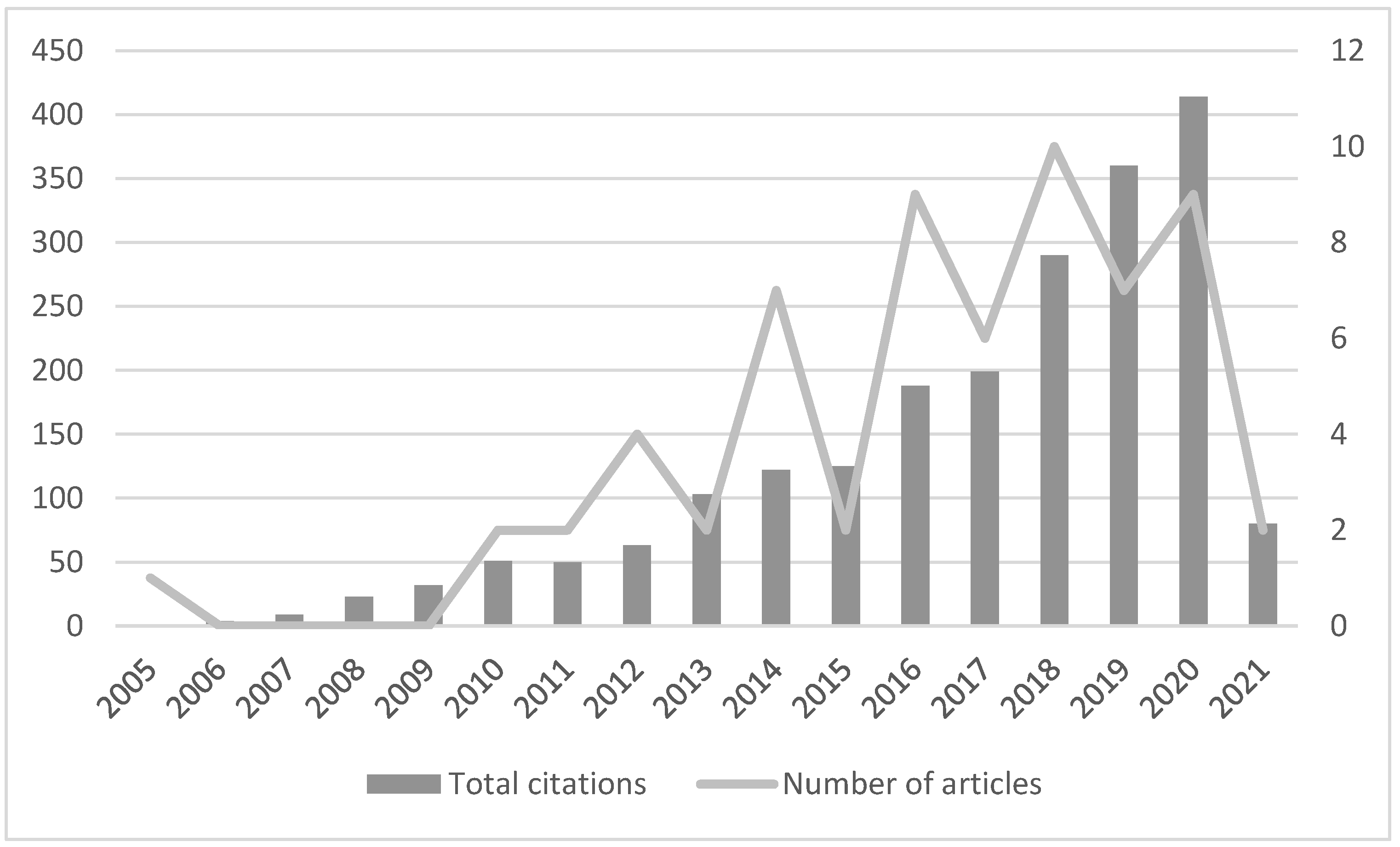
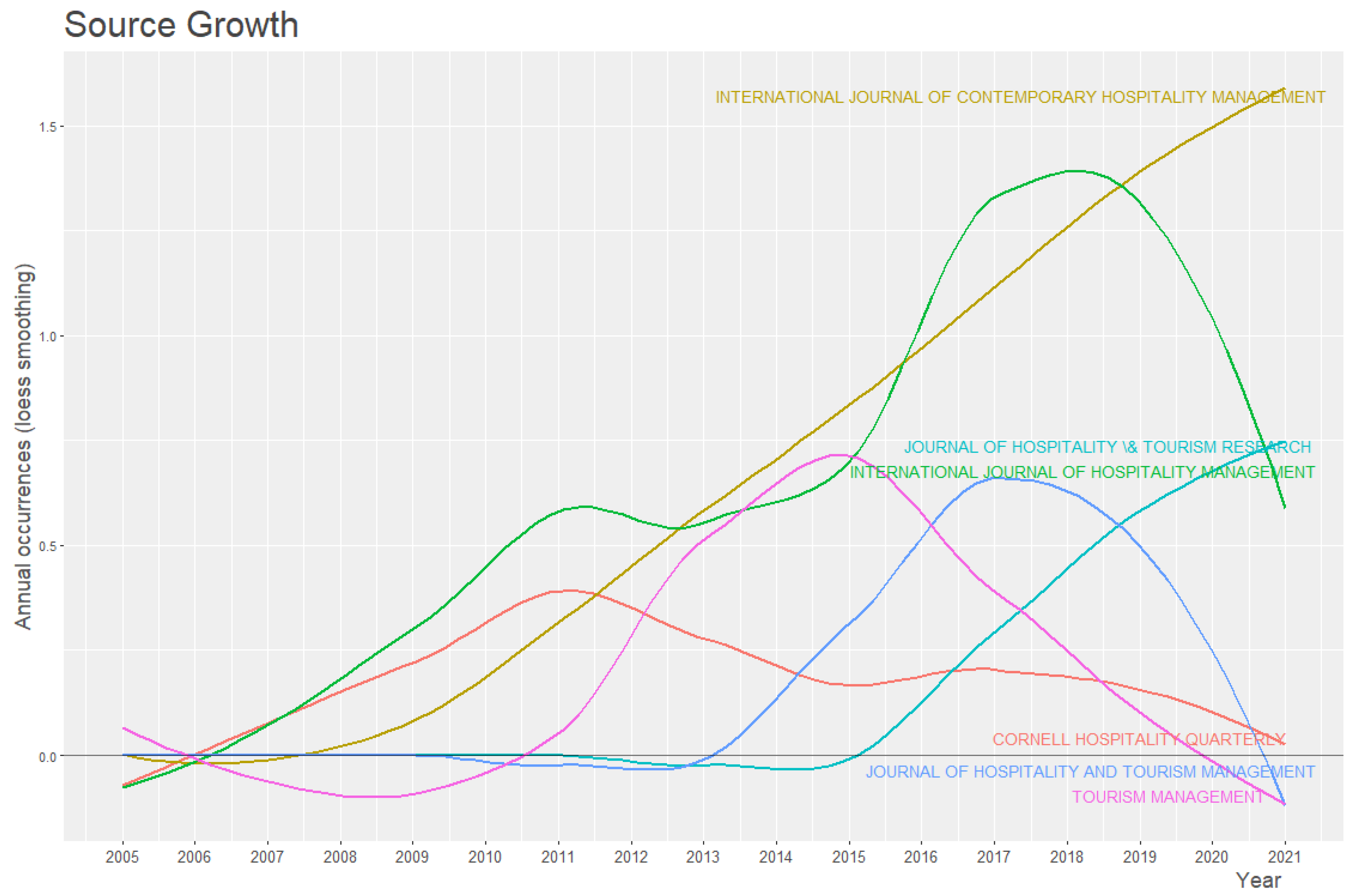

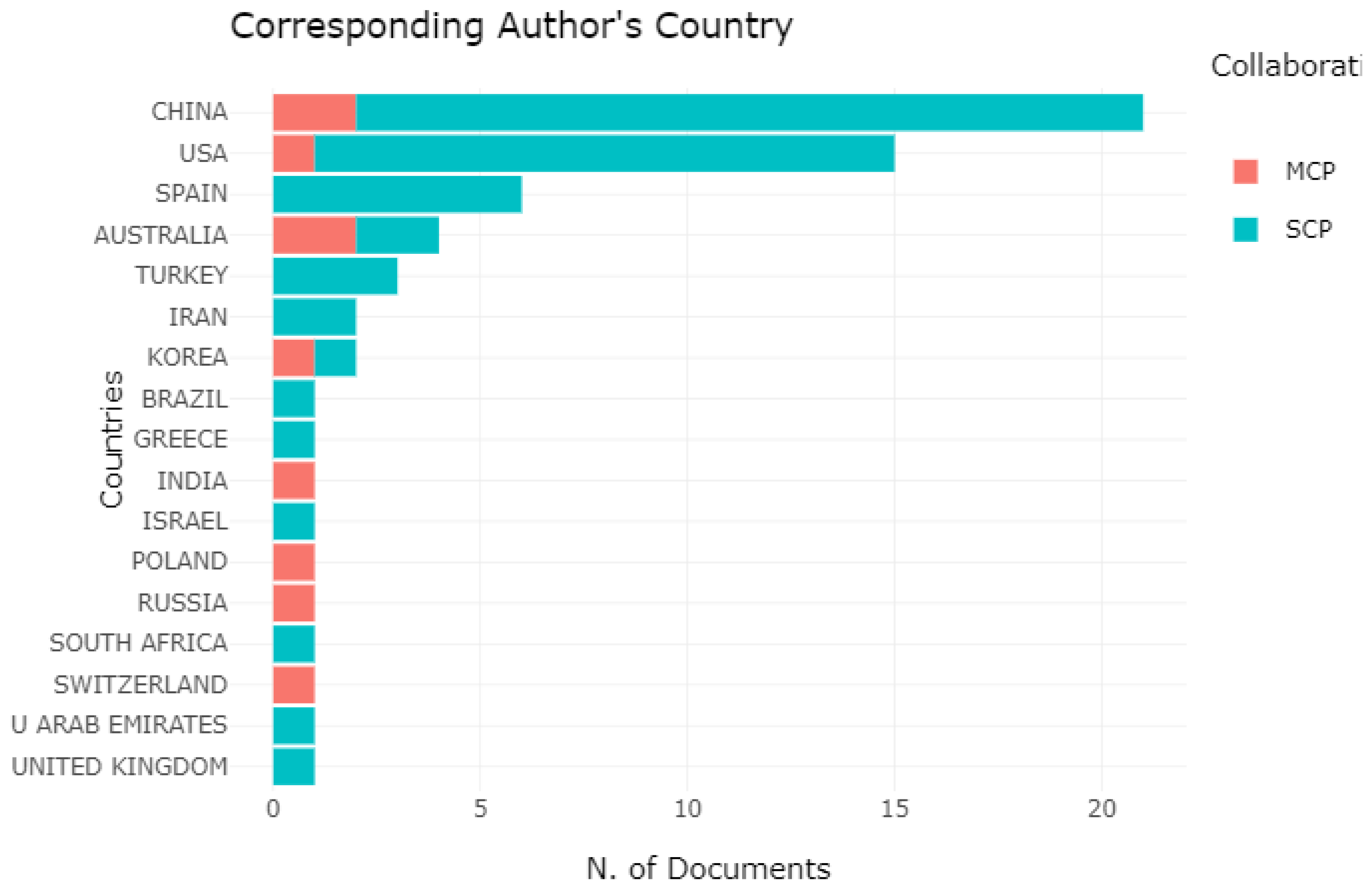
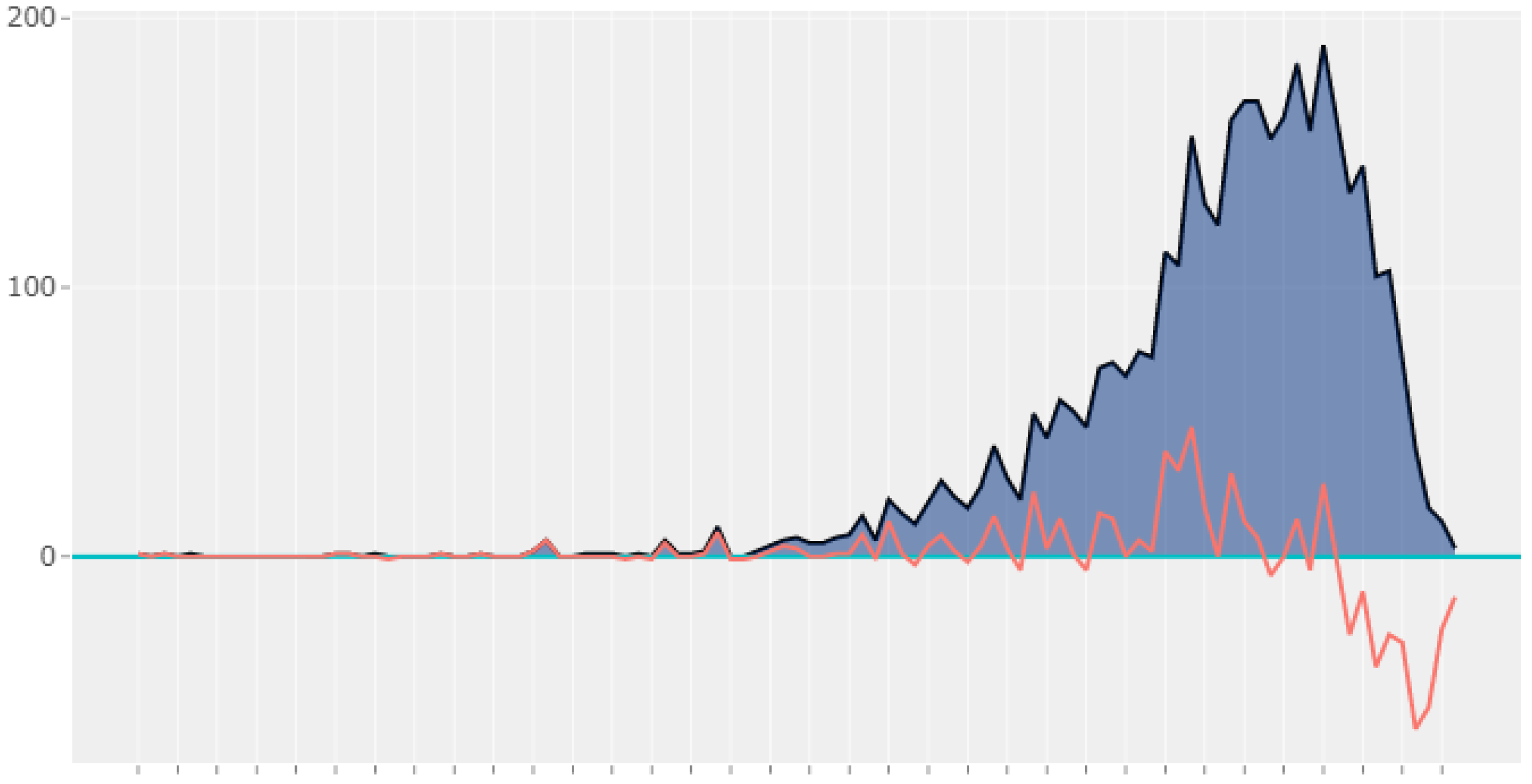

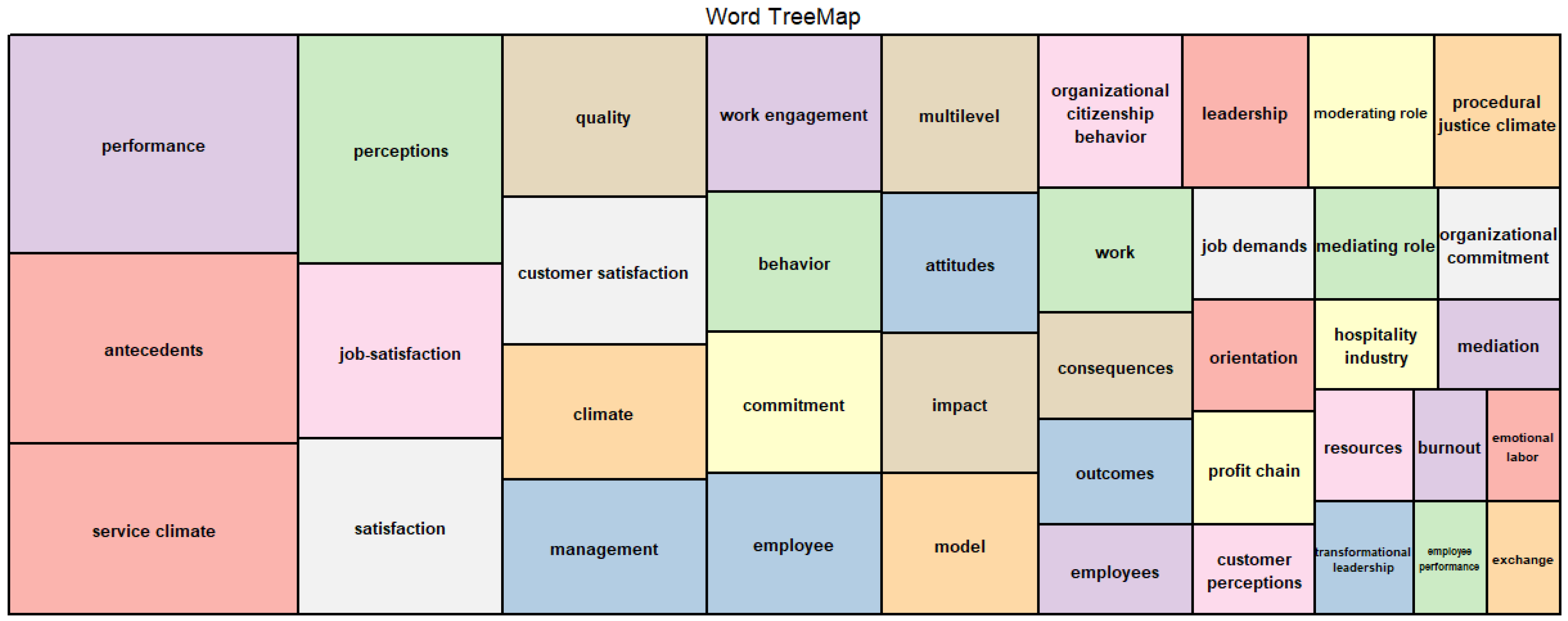
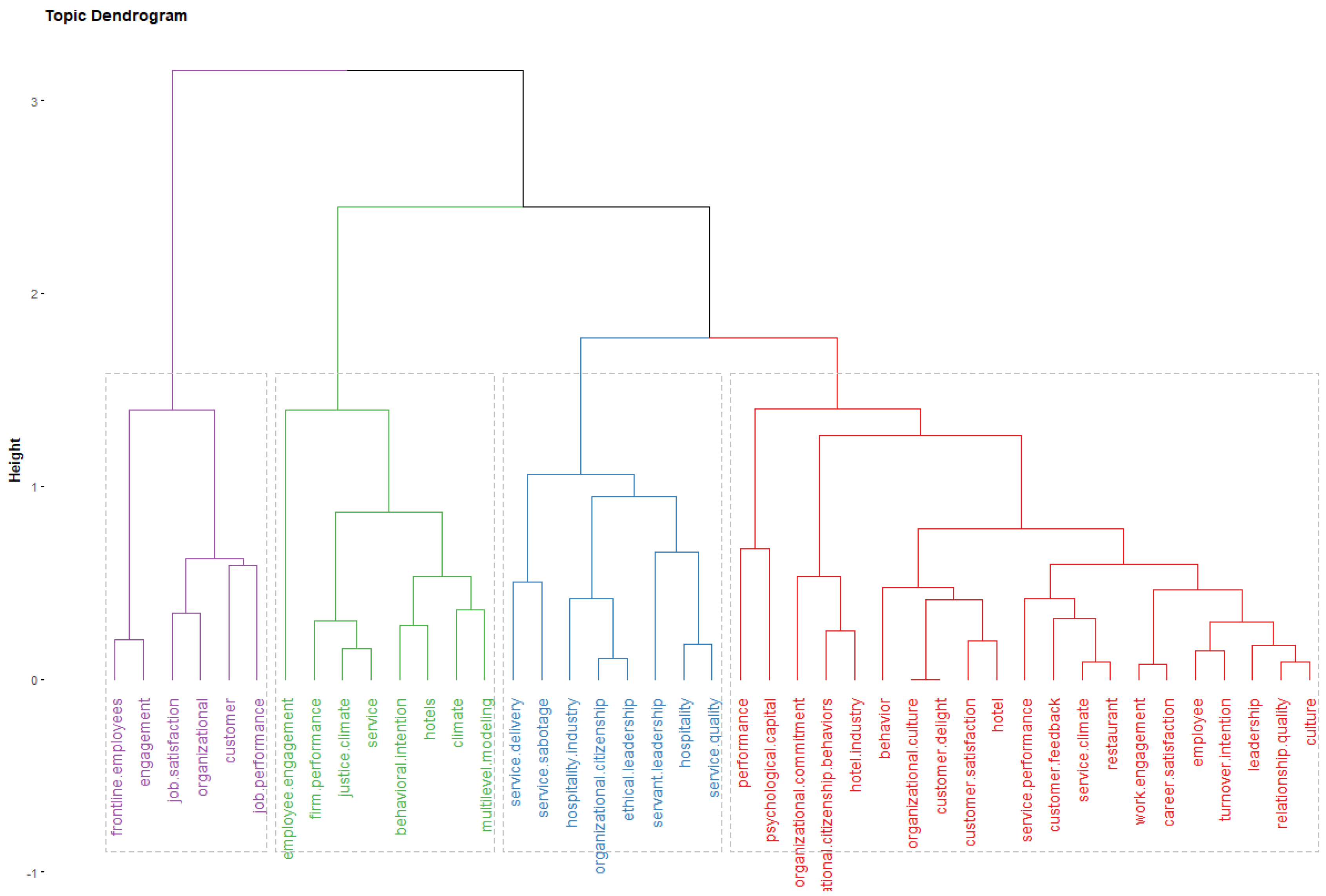
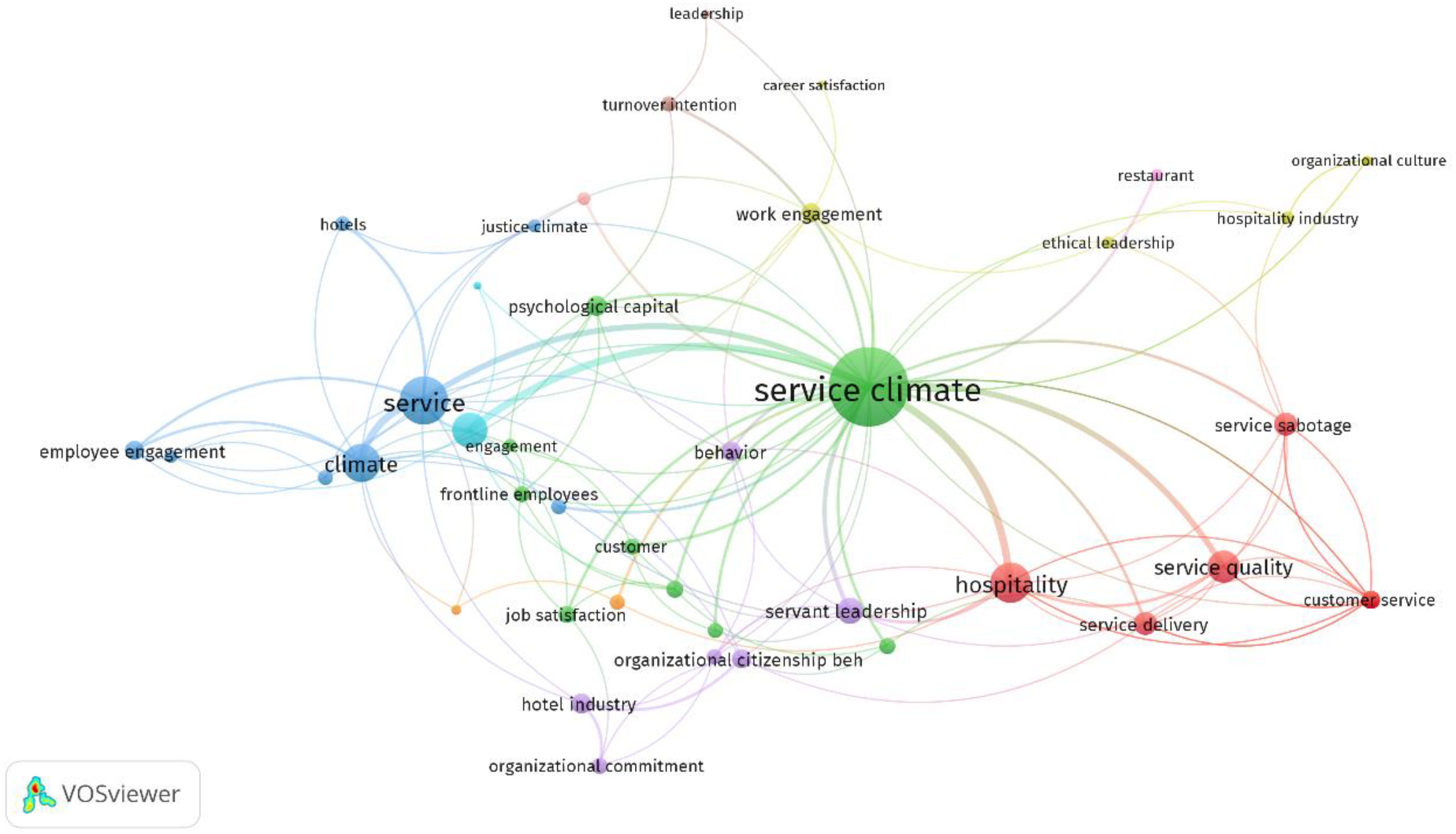

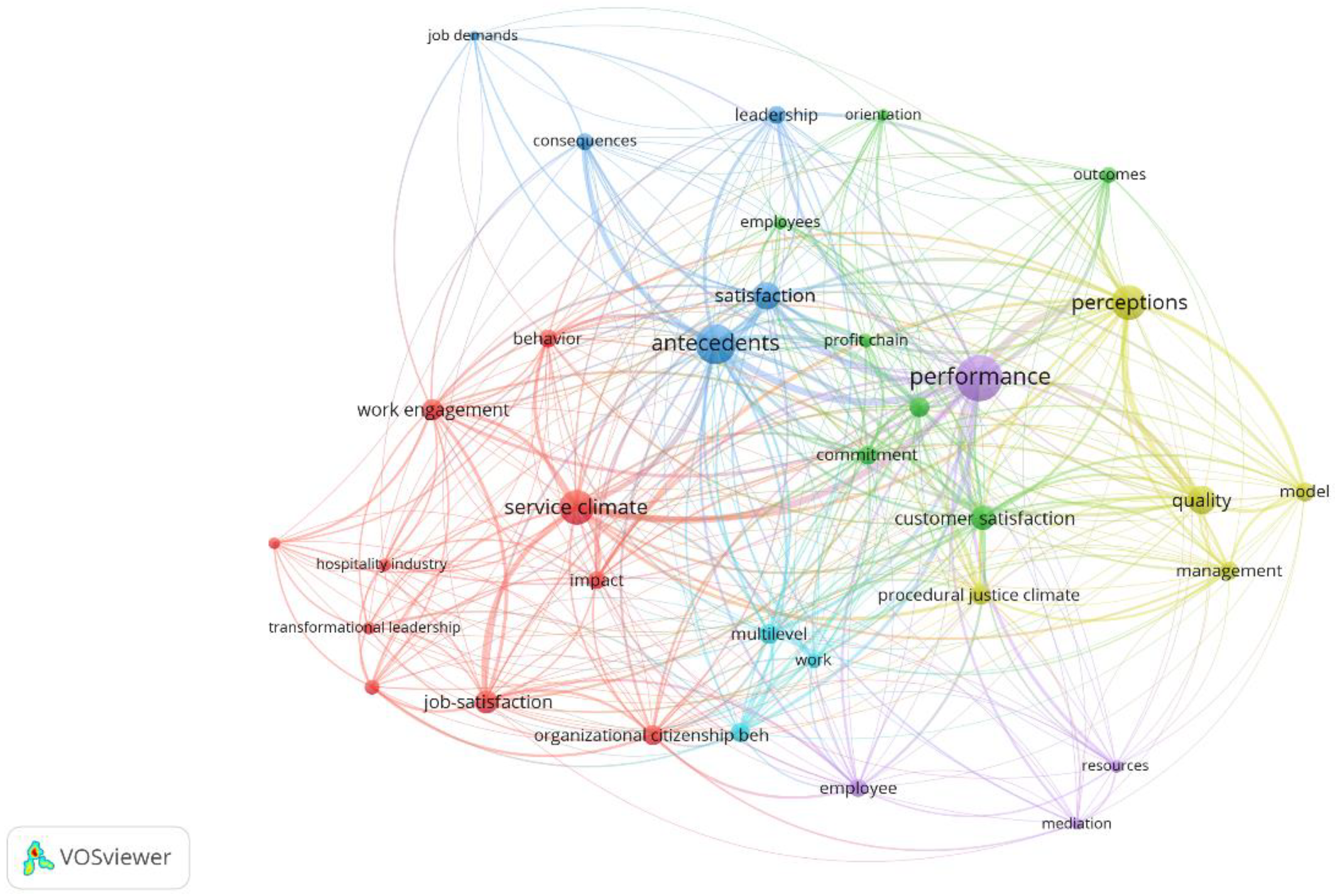
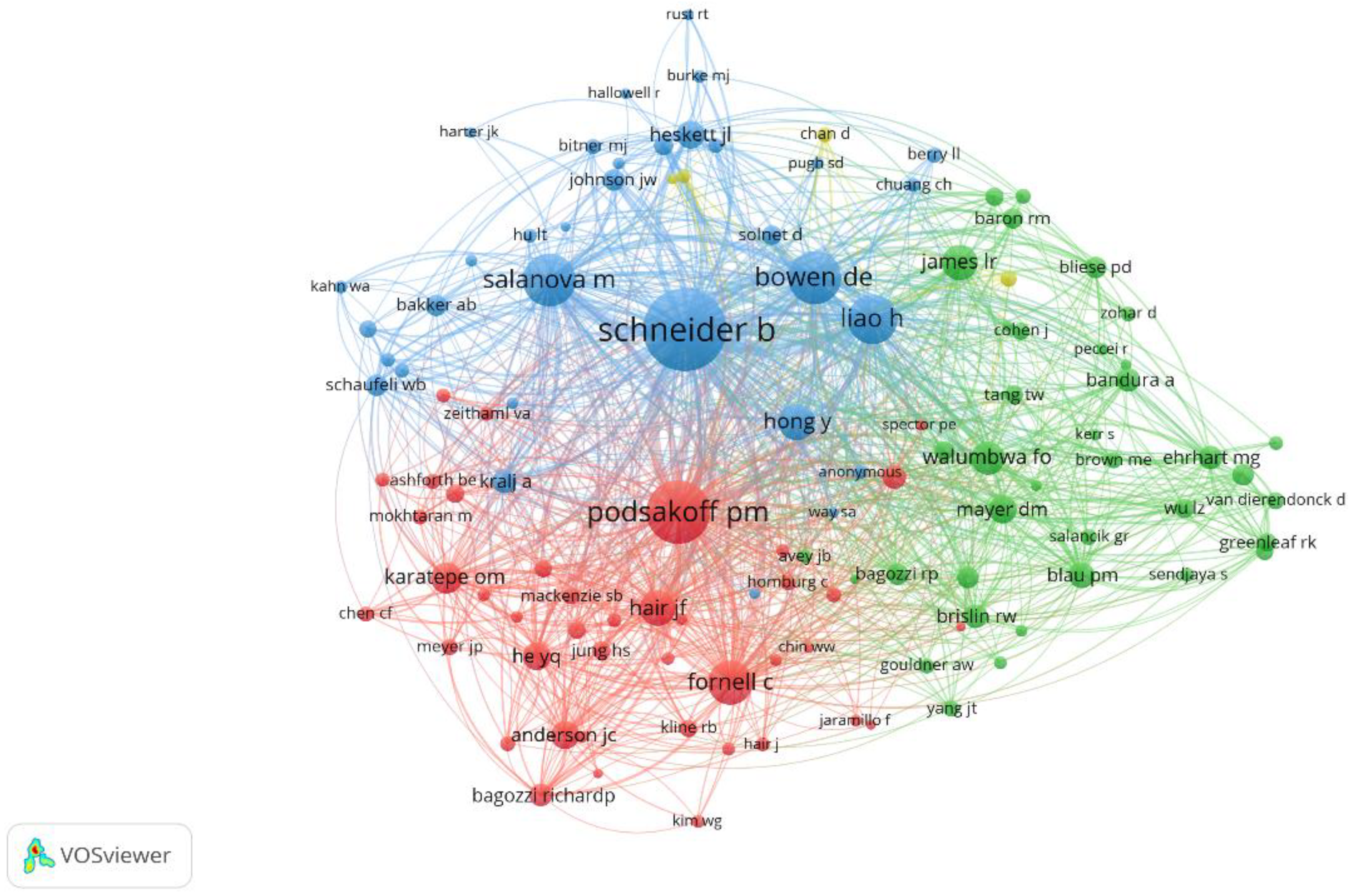
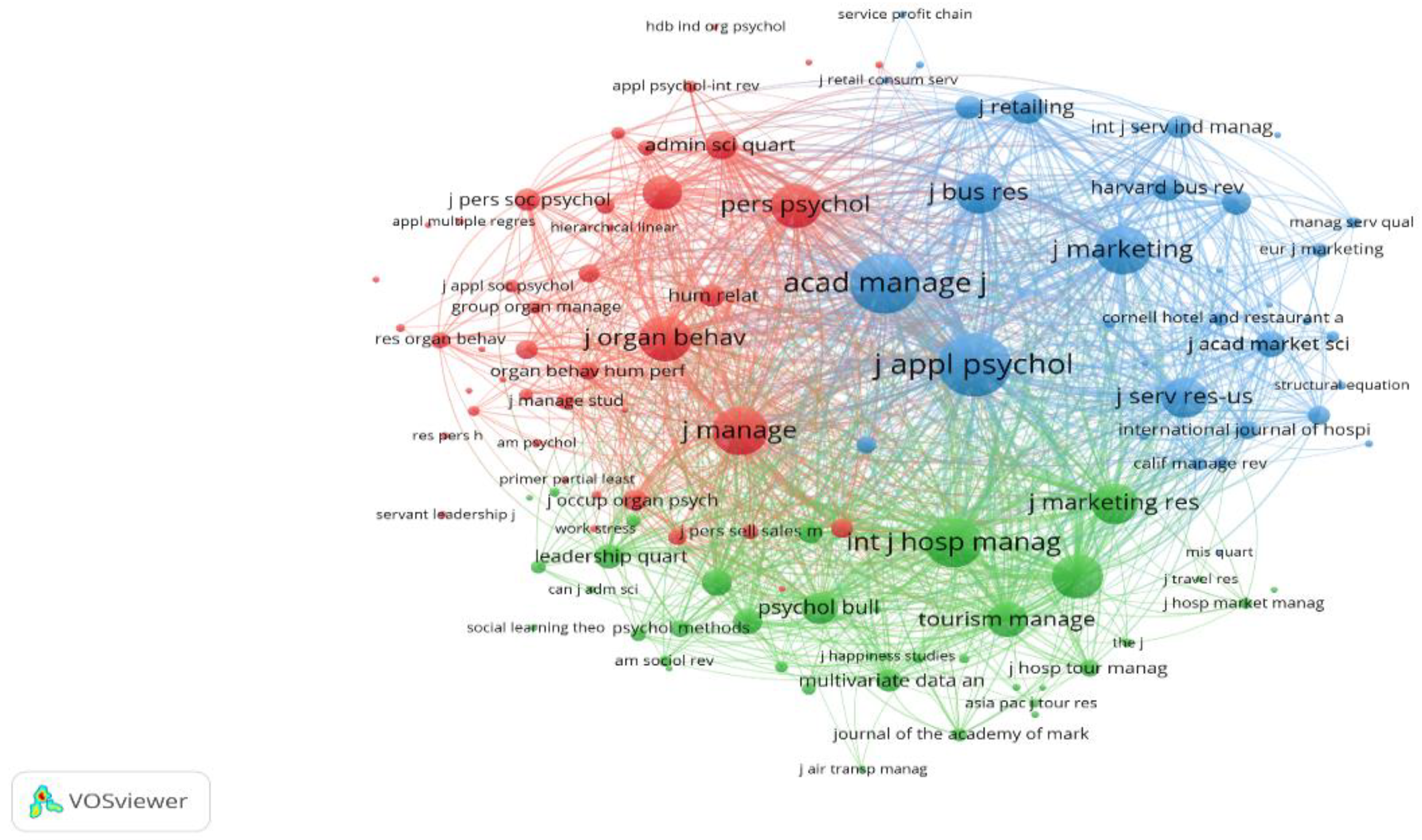
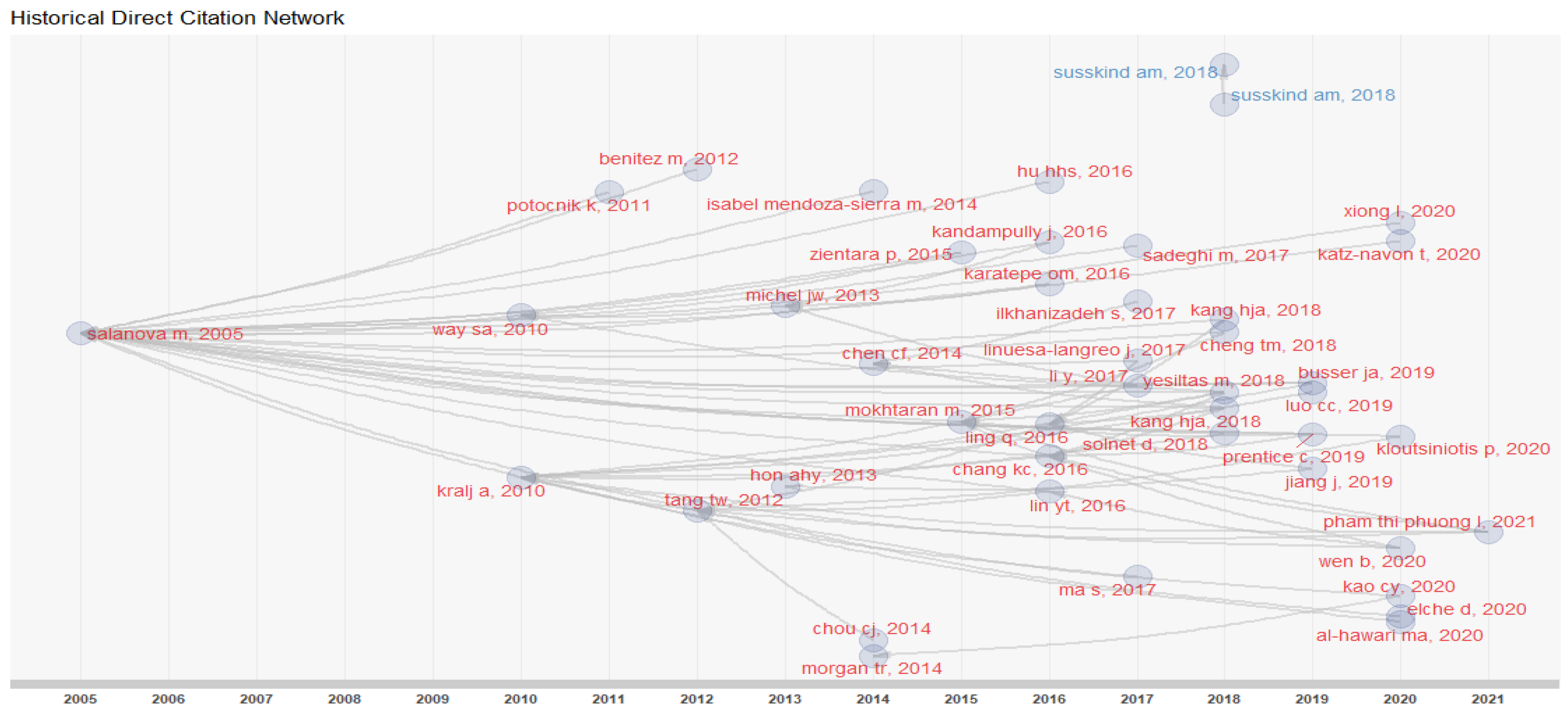
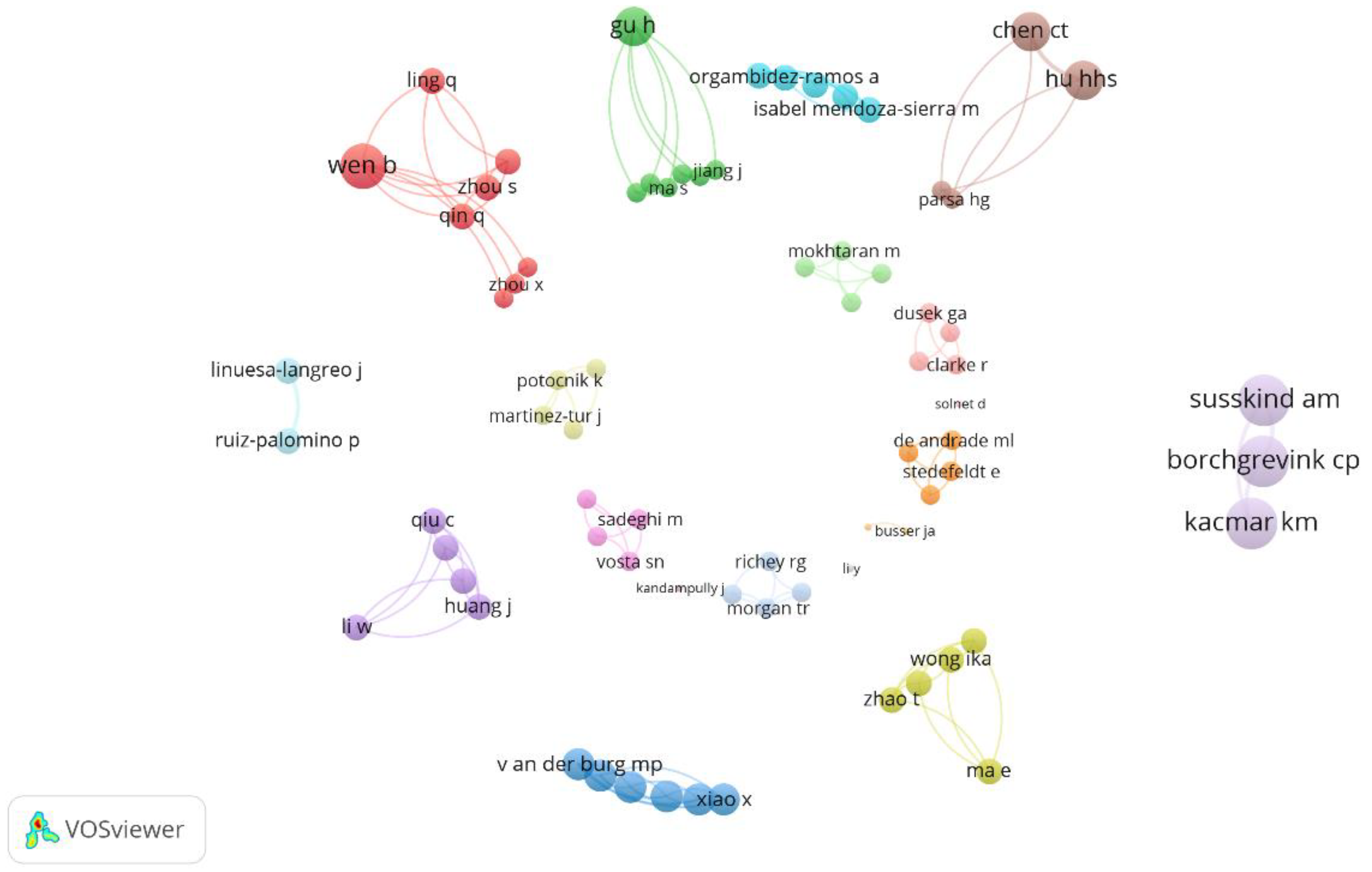
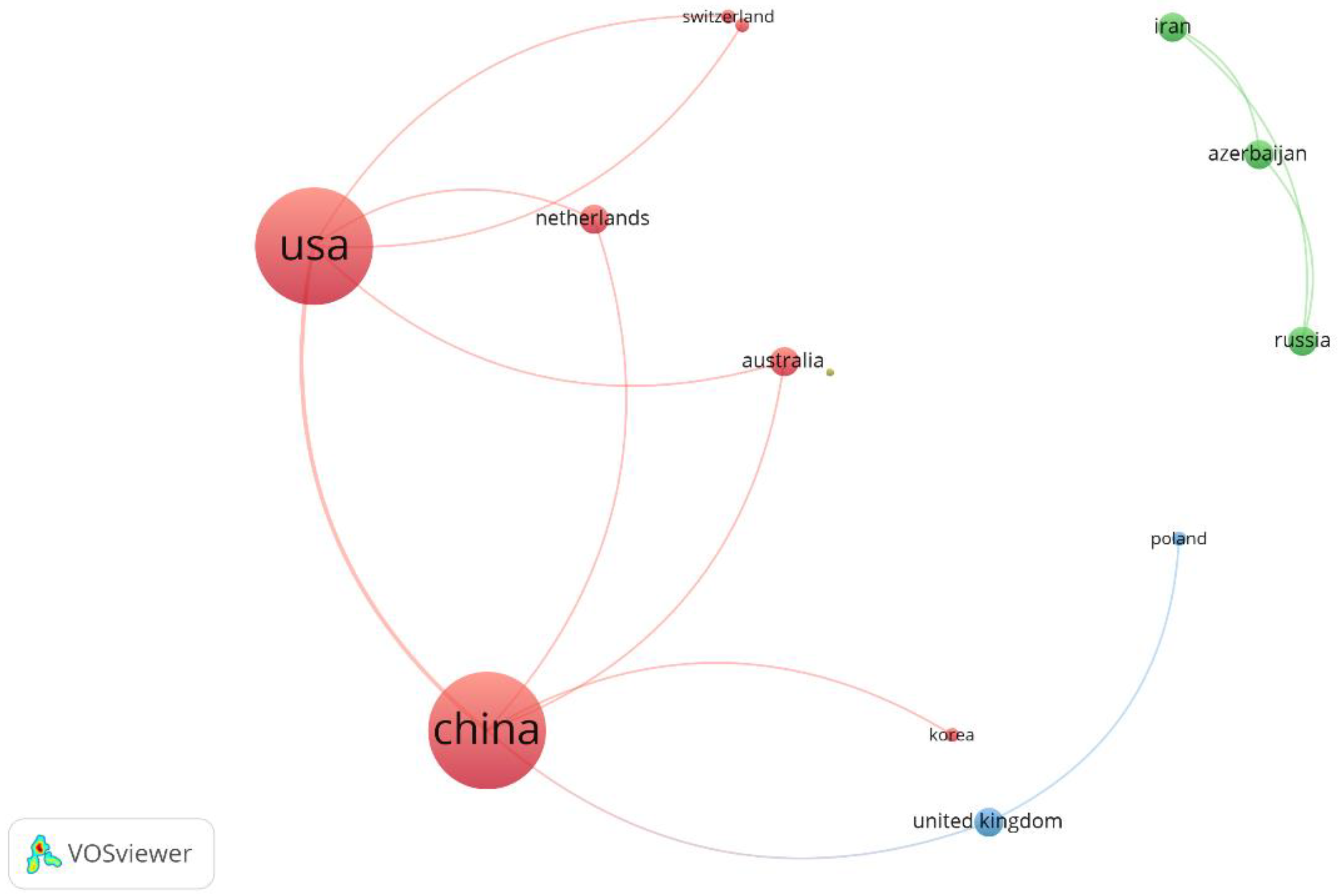
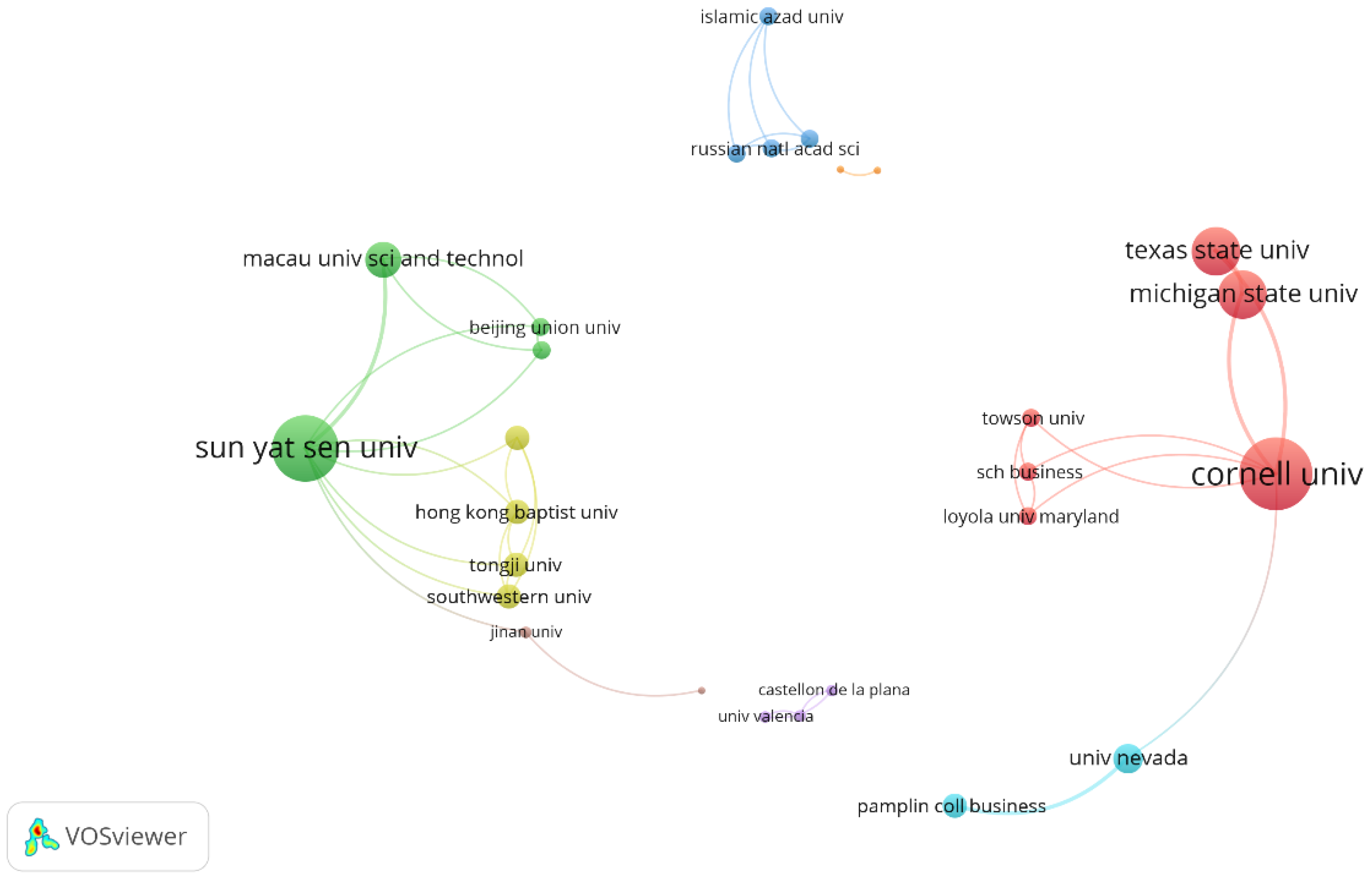
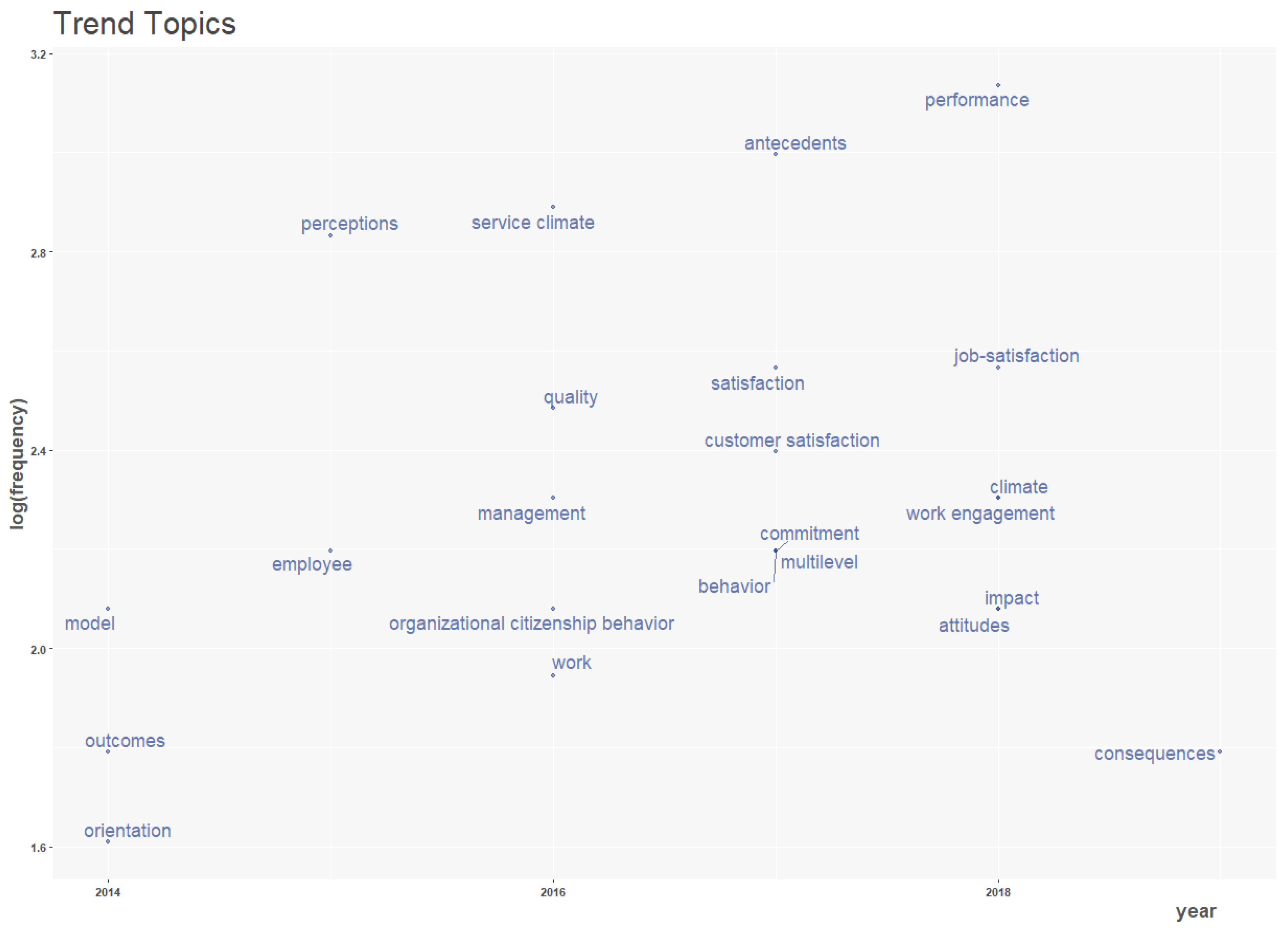
| Eligibility Criteria | WOS |
|---|---|
| índex: sci-expanded, ssci, a&hci, cpci-s, cpci-ssh, esci, ccr-expanded | 435 |
| Hospitality English articles | 70 |
| Proceedings papers | 69 |
| Early access publications | 66 |
| Review articles | 63 |
| Source | H_Index | G_Index | M_Index | TQ | NP | PY_Start |
|---|---|---|---|---|---|---|
| International journal of hospitality management | 7 | 11 | 0.583333333 | 283 | 11 | 2010 |
| International journal of contemporary hospitality management | 6 | 11 | 0.545454545 | 191 | 11 | 2011 |
| Journal of hospitality and tourism management | 3 | 3 | 0.5 | 40 | 3 | 2016 |
| Tourism management | 3 | 3 | 0.375 | 189 | 3 | 2014 |
| Cornell hospitality quarterly | 2 | 3 | 0.166666667 | 70 | 3 | 2010 |
| Frontiers in psychology | 2 | 2 | 0.4 | 13 | 2 | 2017 |
| Journal of air transport management | 2 | 2 | 0.4 | 49 | 2 | 2017 |
| Journal of applied psychology | 2 | 2 | 0.117647059 | 1097 | 2 | 2005 |
| Journal of services marketing | 2 | 2 | 0.25 | 15 | 2 | 2014 |
| Service industries journal | 2 | 2 | 0.333333333 | 17 | 2 | 2016 |
| Journal of hospitality & tourism research | 1 | 2 | 0.25 | 5 | 3 | 2018 |
| Anales de psicologia | 1 | 1 | 0.1 | 9 | 1 | 2012 |
| Asia pacific journal of tourism research | 1 | 1 | 0.142857143 | 21 | 1 | 2015 |
| European journal of work and organizational psychology | 1 | 1 | 0.090909091 | 10 | 1 | 2011 |
| International journal of hospitality & tourism administration | 1 | 1 | 0.25 | 20 | 1 | 2018 |
| International journal of management science and engineering management | 1 | 1 | 0.2 | 6 | 1 | 2017 |
| Iranian journal of management studies | 1 | 1 | 0.166666667 | 5 | 1 | 2016 |
| Journal of east-west business | 1 | 1 | 0.166666667 | 2 | 1 | 2016 |
| Journal of hospitality and tourism insights | 1 | 1 | 0.333333333 | 2 | 1 | 2019 |
| Journal of hospitality marketing & management | 1 | 1 | 0.333333333 | 4 | 1 | 2019 |
| Journal of service theory and practice | 1 | 1 | 0.5 | 3 | 1 | 2020 |
| Journal of sustainable tourism | 1 | 1 | 0.142857143 | 27 | 1 | 2015 |
| Journal of travel & tourism marketing | 1 | 1 | 0.166666667 | 1 | 1 | 2016 |
| Land use policy | 1 | 1 | 0.333333333 | 8 | 1 | 2019 |
| Managing service quality | 1 | 1 | 0.1 | 11 | 1 | 2012 |
| Marine mammal science | 1 | 1 | 0.125 | 13 | 1 | 2014 |
| Spanish journal of psychology | 1 | 1 | 0.125 | 2 | 1 | 2014 |
| Journal of interdisciplinary mathematics | 0 | 0 | 0 | 0 | 1 | 2017 |
| Journal of retailing and consumer services | 0 | 0 | 0 | 0 | 1 | 2020 |
| Sustainability | 0 | 0 | 0 | 0 | 1 | 2021 |
| Year | Total Quotations TQ (63 Articles) | Number of Articles | MeanTQperArt | MeanTQperYear | Citable Years |
|---|---|---|---|---|---|
| 2005 | 0 | 1 | 975 | 60.9375 | 16 |
| 2006 | 4 | 0 | 0 | 0 | 0 |
| 2007 | 9 | 0 | 0 | 0 | 0 |
| 2008 | 23 | 0 | 0 | 0 | 0 |
| 2009 | 32 | 0 | 0 | 0 | 0 |
| 2010 | 51 | 2 | 44.5 | 4.045454545 | 11 |
| 2011 | 50 | 2 | 33 | 3.3 | 10 |
| 2012 | 63 | 4 | 59.25 | 6.583333333 | 9 |
| 2013 | 103 | 2 | 28.5 | 3.5625 | 8 |
| 2014 | 122 | 7 | 30.57142857 | 4.367346939 | 7 |
| 2015 | 125 | 2 | 24 | 4 | 6 |
| 2016 | 188 | 9 | 23.44444444 | 4.688888889 | 5 |
| 2017 | 199 | 6 | 13 | 3.25 | 4 |
| 2018 | 290 | 10 | 10 | 3.333333333 | 3 |
| 2019 | 360 | 7 | 3.142857143 | 1.571428571 | 2 |
| 2020 | 414 | 9 | 1.777777778 | 1.777777778 | 1 |
| 2021 | 80 | 2 | 0 | 0 | 0 |
| 2113 | 63 |
| AU | TI | PY | Total Quotations | TC per Year | SO |
|---|---|---|---|---|---|
| Salanova, M.; Agut, S.; Peiro, J.M. | Linking Organizational Resources And Work Engagement To Employee Performance And Customer Loyalty: The Mediation Of Service Climate | 2005 | 975 | 57.353 | Journal Of Applied Psychology |
| Raub, S.; Liao, H. | Doing The Right Thing Without Being Told: Joint Effects Of Initiative Climate And General Self-Efficacy On Employee Proactive Customer Service Perform | 2012 | 122 | 12.2 | Journal Of Applied Psychology |
| Chou, C.J. | Hotels’ Environmental Policies And Employee Personal Environmental Beliefs: Interactions And Outcomes | 2014 | 112 | 14 | Tourism Management |
| Tang, T.W.; Tang, Y.Y. | Promoting Service-Oriented Organizational Citizenship Behaviors In Hotels: The Role Of High-Performance Human Resource Practices And Organizational So | 2012 | 95 | 9.5 | International Journal Of Hospitality Management |
| Chang, K.C | Effect Of Servicescape On Customer Behavioral Intentions: Moderating Roles Of Service Climate And Employee Engagement | 2016 | 66 | 11 | International Journal Of Hospitality Management |
| Ling, Q.; Lin, M.; Wu, X. | The Trickle-Down Effect Of Servant Leadership On Frontline Employee Service Behaviors And Performance: A Multilevel Study Of Chinese Hotels | 2016 | 64 | 10.667 | Tourism Management |
| He, Y.; Li, W.; Lai, K.K. | Service Climate, Employee Commitment And Customer Satisfaction Evidence From The Hospitality Industry In China | 2011 | 56 | 5.091 | International Journal Of Contemporary Hospitality Management |
| Kralj, A.; Solnet, D. | Service Climate And Customer Satisfaction In A Casino Hotel: An Exploratory Case Study | 2010 | 48 | 4 | International Journal Of Hospitality Management |
| Way, S.A.; Sturman, M.C.; Raab, C. | What Matters More? Contrasting The Effects Of Job Satisfaction And Service Climate On Hotel Food And Beverage Managers’ Job Performance | 2010 | 41 | 3.417 | Cornell Hospitality Quarterly |
| Fu, H.; Li, Y.; Duan, Y. | Does Employee-Perceived Reputation Contribute To Citizenship Behavior? The Mediating Role Of Organizational Commitment | 2014 | 37 | 4.625 | International Journal Of Contemporary Hospitality Management |
Publisher’s Note: MDPI stays neutral with regard to jurisdictional claims in published maps and institutional affiliations. |
© 2021 by the authors. Licensee MDPI, Basel, Switzerland. This article is an open access article distributed under the terms and conditions of the Creative Commons Attribution (CC BY) license (https://creativecommons.org/licenses/by/4.0/).
Share and Cite
Palácios, H.; Almeida, H.d.; Sousa, M.J. A Bibliometric Analysis of Service Climate as a Sustainable Competitive Advantage in Hospitality. Sustainability 2021, 13, 12214. https://doi.org/10.3390/su132112214
Palácios H, Almeida Hd, Sousa MJ. A Bibliometric Analysis of Service Climate as a Sustainable Competitive Advantage in Hospitality. Sustainability. 2021; 13(21):12214. https://doi.org/10.3390/su132112214
Chicago/Turabian StylePalácios, Hugo, Helena de Almeida, and Maria José Sousa. 2021. "A Bibliometric Analysis of Service Climate as a Sustainable Competitive Advantage in Hospitality" Sustainability 13, no. 21: 12214. https://doi.org/10.3390/su132112214
APA StylePalácios, H., Almeida, H. d., & Sousa, M. J. (2021). A Bibliometric Analysis of Service Climate as a Sustainable Competitive Advantage in Hospitality. Sustainability, 13(21), 12214. https://doi.org/10.3390/su132112214







